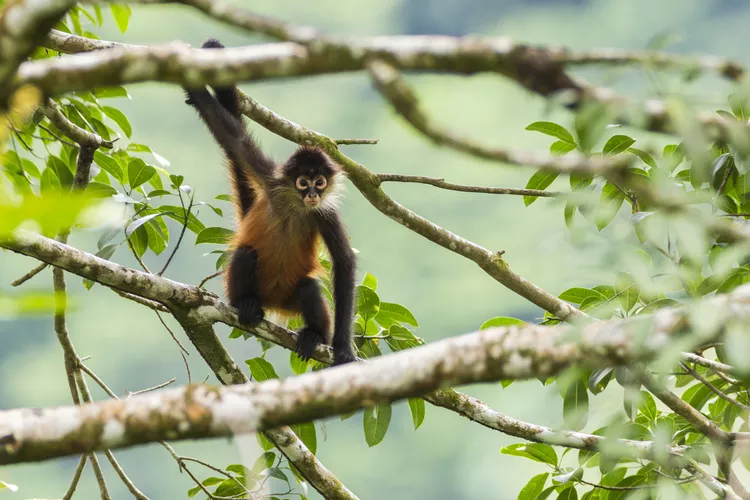Monkeys have evolved a remarkable array of adaptations that allow them to thrive in a diverse range of habitats.
Their ability to adapt both physically and behaviorally is crucial to their survival.
In this article, we’ll explore the key physical and behavioral adaptations that enable different monkey species to find food, navigate their homes, and survive predators in rainforests, forests, savannas, and more.
How Do Monkeys Adapt to Their Environment?
Monkeys are incredibly adaptive primates that evolve both physically and behaviorally to thrive in diverse environments worldwide, from tropical rainforests to open savannas.
Their remarkable flexibility enables different species to find food, navigate terrain, and survive predators.
Key Points
- Monkeys have specialized adaptations like prehensile tails, strong legs, keen vision, and vocalizations.
- They exhibit adaptive behaviors like group foraging, seasonal migration, and tail-flagging.
- Rainforest monkeys use color vision, large groups, and loud calls.
- Savanna monkeys have speed, small bodies, and tree sleeping sites.
How Do Monkeys Interact With Their Environment?
As highly intelligent and social primates, monkeys interact with their environments in complex ways.
They form intricate social groups with hierarchies and relationships.
Many monkeys utilize tools to access food like cracking nuts with rocks or probing holes with sticks.
Through communication like calls, facial expressions, and tail gestures, monkeys share information about food sources and threats in their environment.
Monkeys play key ecological roles by dispersing seeds as they eat and fertilizing forests with their droppings.
Their foraging shapes forest structure and composition.
Many species have symbiotic relationships with other animals.
For example, some birds eat parasites off monkey fur.
Monkeys are both influenced by and influence their habitats.
However, human activities are disrupting these complex interactions, emphasizing the need for conservation.
Overall, monkeys have multifaceted, reciprocal relationships with their environments.
How Do Monkeys Use Behavioral Adaptations?
In addition to physical adaptations, monkeys exhibit a range of behavioral adaptations that enable them to find food, stay safe, and interact with their environments.
- Foraging in Small Groups – Many monkey species, like capuchin monkeys and squirrel monkeys, travel and forage for food in small groups. There is safety in numbers, and being part of a troop reduces an individual monkey’s chances of being preyed upon. Group foraging also allows monkeys to cover more ground.
- Utilizing Different Forest Strata – Some monkeys strategically utilize different forest levels or “strata” when foraging. Spider monkeys spend most of their time feeding in the high canopy, while capuchin monkeys do a lot more feeding at lower levels. Strategically using all the resources, the forest offers allows multiple monkey species to inhabit the same area.
- Tail-Flagging as Communication – Many forest-dwelling monkeys communicate using “tail-flagging” gestures. They rapidly flick their tails to signal alarm or communicate aggression toward intruders. Other monkeys can see these flagged tails from a distance as a warning. This adaptation allows troops to silently notify others of possible danger.
- Seasonal Migration Following Food Sources – Some monkeys, like southern muriquis, migrate seasonally to follow the most abundant food sources. As fruits and flowers become more plentiful in different areas, the monkeys will travel to take advantage of the bounty. This migration allows them to survive in seasonal forests.
How Are Monkeys Specially Adapted to Rainforests?
Tropical rainforests present unique challenges for monkeys with their dense vegetation, low light levels, and diversity of predators.
Rainforest-dwelling monkeys have evolved adaptations that help them thrive in this unique environment.
- Prehensile Tails – A prehensile tail is essential for monkeys living high in the rainforest canopy. The tail acts as a fifth limb, allowing monkeys to efficiently climb, hang, reach, and brace themselves on branches and vines. Monkeys also rely heavily on their prehensile tails for feeding, using them to pick fruits and grip branches while freeing up their hands to eat.
- Color Vision – Most rainforest monkeys have highly specialized color vision, unlike most mammals. This allows them to spot colorful ripe fruits in the dense jungle. It also enables them to identify toxic or unripe fruits to avoid. Their excellent color vision gives them an edge when foraging.
- Large Groups – Many rainforest monkey troops are quite large, sometimes numbering over 100 individuals. There is strength in numbers, and large troops help deter predators. Large groups also make it easier to find patchy food sources in the dense forest.
- Loud Vocalizations – Rainforest monkeys often have loud, resonating vocalizations that allow them to communicate and coordinate over long distances in the dense jungle. Loud warning calls quickly alert others in their troop to lurking dangers.
How Do Monkeys Navigate Forest Habitats?
Forests present obstacles like tall trees, dense vegetation, and uneven terrain that monkeys must adapt to when traveling and foraging.
Monkeys use the following adaptations to expertly navigate their arboreal homes:
- Brachiation – Gibbons and siamangs navigate the forest canopy by swinging from branch to branch, a method of locomotion called brachiation. Their long arms allow them to reach the next handhold while using their momentum to quickly swing through the trees.
- Vertical Clinging and Leaping – Smaller monkeys like tamarins and marmosets use a strategy called vertical clinging and leaping to move through the forest. They rapidly climb up vertical tree trunks, then make targeted leaps to cross to another trunk.
- Prehensile Tails – A prehensile tail acts as a fifth limb used for grasping branches as monkeys climb, forage, and leap through the forest. The tail provides balance and security.
- Rotating Joints – The shoulders, wrists, hips, and ankles of arboreal monkeys can all rotate, allowing them to securely grasp branches in a range of orientations as they move through the canopy.
How Do Savanna Monkeys Adapt to Open Environments?
Compared to dense rainforests, open savanna landscapes pose a different set of challenges for monkeys.
Savanna-dwelling monkeys have made adaptations to take advantage of sparse forest patches while reducing risks.
- Powerful Legs for Speed – Ground monkeys like baboons and patas monkeys have incredibly muscular, long hind legs that allow them to run at remarkable speeds across open terrain when needed to escape predators.
- Small, Lean Bodies – A smaller body frame with lean muscle helps monkeys like vervets and guenons traverse longer distances across open savannas to find patchy food resources and water sources. Their nimble bodies also allow quick dodging to avoid predators.
- Omnivorous Diet – Baboons are omnivorous primates, eating a diverse diet including grasses, roots, berries, and small mammals. This gives them a flexible diet to take advantage of whatever food resources they encounter on the savanna.
- Large Social Groups – Ground monkeys form very large social groups or “troops” for protection in more exposed savanna environments. A troop can include up to 200 individuals! There is strength in numbers, and most predators will think twice before attacking such a large group.
- Tree Sleeping Sites – Although savanna monkeys spend their day foraging on the ground, they usually sleep in trees at night where they are safer from nocturnal predators like lions and hyenas.
How Do Different Monkey Species Interact With Their Environment?
There are over 260 different monkey species worldwide, and each interacts and adapts to its environment in unique ways depending on the challenges they face.
Here are some examples:
- Spider Monkeys – Spider monkeys are found in tropical rainforests. They are highly adapted for living in the upper canopy, rarely coming down to the forest floor. Their incredibly long limbs and prehensile tails allow them to brachiate through the treetops to find fruits and tender leaves to eat.
- Geladas – Geladas are the only grass-eating monkeys, living in Ethiopian highland regions that are too steep for most other grazers. They have specialized teeth for chewing grass and sleep on cliffs at night where predators can’t reach them.
- Snub-Nosed Monkeys – These monkeys inhabit mountain forests in China. They have adapted to cold winters thanks to a thick coat and rhinarium (skin around their nostrils) that heats incoming air before it reaches their lungs.
- Rhesus Monkeys – This savvy monkey thrives in forests and cities in Asia. They are highly monkeys. They are very flexible and adaptable, able to modify their diet and habits to take advantage of human environments.
- Uakaris – Found in swampy Amazonian forests, these monkeys have short, water-resistant fur specially adapted for a damp environment. They also have long tails for balance while traversing flooded forests.
How are monkeys adapted to survive the winter?
Monkeys living in temperate regions have evolved adaptations to survive frigid winters.
In colder climates, food becomes scarce in winter, so monkeys have more extensive home ranges and spend more time foraging to find limited resources.
They have seasonal breeding patterns timed for summer birthing when food is plentiful.
Monkeys grow thick winter coats to conserve heat.
For example, the Japanese macaque has a winter coat with extra fat and longer fur to keep warm in freezing temperatures and heavy snow.
Barbary macaques in Europe’s mountains have shaggy fur adapted to retain heat in winter.
Snub-nosed monkeys in China’s mountains have a specialized rhinarium that warms incoming air before it reaches their lungs, preventing cold air from chilling them.
Many temperate monkey species gather into larger groups in winter for added warmth.
Overall, monkeys use behavioral adaptations like extended foraging and group huddling as well as physical adaptations like heavy fur and fat layers to survive frigid winters.
The Bottom Line
The incredible adaptability of monkeys allows them to inhabit diverse environments worldwide.
Their physical and behavioral adaptations are shaped by the unique conditions and challenges of their habitats over tens of thousands of years.
Continued study of monkeys provides fascinating insights into how evolution equips different species to interact and thrive within their worlds.
FAQ
What physical adaptations help arboreal monkeys?
Monkeys that live in trees have adapted with prehensile tails, flexible shoulder joints, and rotatable wrists that allow them to securely grip branches at any angle while climbing and swinging through the canopy. This helps them safely navigate their arboreal homes.
How does a monkey’s diet relate to their environment?
Different monkey species have evolved varied diets and teeth to match the food sources available in their particular habitats. Frugivores like spider monkeys have teeth adept at consuming soft fruits, while insectivores like tamarins have large incisors for crunching bugs. This diet specialization aids survival.
Why do savanna monkeys form large troops?
In open savanna environments, ground-dwelling monkeys form huge social groups called troops, sometimes numbering over 100 individuals. These sizable groups deter predators and provide security in an exposed habitat. There is strength in numbers on the savanna.
At GreenChiCafe, we are passionate about our amazing planet and working to protect the natural world. For more on world environments and the species that call them home, check out GreenChiCafe.com today!

Annie is a passionate environmental writer and activist. She has been writing about sustainability, conservation, and green living for over 15+ years. Annie is dedicated to raising awareness about environmental issues and providing practical tips for living an eco-friendly lifestyle. When she’s not writing, you can find her volunteering with local environmental organizations, teaching workshops on zero waste living, or exploring nature. Feel free to get in touch with Annie: annie@greenchicafe.com


